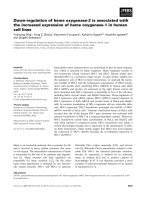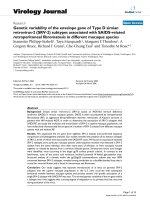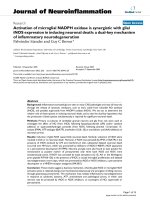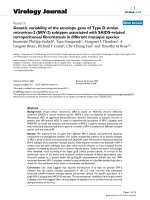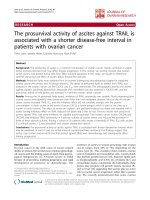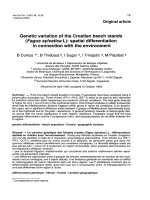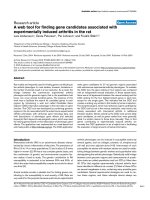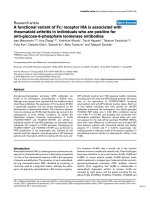A genetic variant of the NTCP gene is associated with HBV infection status in a Chinese population
Bạn đang xem bản rút gọn của tài liệu. Xem và tải ngay bản đầy đủ của tài liệu tại đây (550.02 KB, 8 trang )
Yang et al. BMC Cancer (2016) 16:211
DOI 10.1186/s12885-016-2257-6
RESEARCH ARTICLE
Open Access
A genetic variant of the NTCP gene is
associated with HBV infection status in a
Chinese population
Jingmin Yang1,2†, Yuan Yang3,4†, Mingying Xia1,2, Lianghui Wang1,2, Weiping Zhou3,5, Yajun Yang1,2,
Yueming Jiang1,2, Hongyang Wang3,4,5, Ji Qian6,7,1,2*, Li Jin1,2* and Xiaofeng Wang1,2*
Abstract
Background: To investigate whether genetic variants of the HBV receptor gene NTCP are associated with HBV
infection in the Han Chinese population.
Methods: We sequenced the entire 23 kb NTCP gene from 111 HBeAg-positive HBsAg carriers (PSE group), 110
HBeAg-negative HBsAg carriers (PS group), and 110 control subjects. Then, we performed association analyses of
suggestively significant SNPs with HBV infection in 1075 controls, 1936 PSs and 639 PSEs.
Results: In total, 109 rare variants (74 novel) and 38 single nucleotide polymorphisms (SNPs, one novel) were screened.
Of the seven non-synonymous rare variants, six were singletons and one was a double hit. All three damaging rare
singletons presented exclusively in the PSE group. Of the five SNPs validated in all 3650 subjects, the T allele of
rs4646287 was significantly decreased (p = 0.002) in the PS group (10.1 %) and PSE group (8.1 %) compared to the
controls (10.9 %) and was decreased to 7.4 % in the PSE hepatocellular carcinoma (HCC) subgroup. Additionally,
rs4646287-T was associated with a 0.68-fold (95 % CI = 0.51–0.89, p = 0.006) decreased risk of PSE compared with the
controls. The NTCP mRNA level was lower in HCC tissues in “CT + TT” carriers than in “CC” carriers.
Conclusions: We found a genetic variant (rs4646287) located in intron 1 of NTCP that may be associated with
increased risk of HBV infection in Han Chinese.
Keyword: HBV-receptor, NTCP, Genetic variant, HBV infection status, Association, rs4646287
Background
Hepatitis B virus (HBV) infection is a major global public
health issue. Serological evidence of HBV infection was
observed in approximately one-third of the world’s population, of which 350–400 million people were chronically
infected [1]. Individuals infected with HBV are at high risk
for the development of cirrhosis, liver failure, or hepatocellular carcinoma (HCC) [2, 3]. HBV is a DNA virus that
* Correspondence: ; ;
†
Equal contributors
6
Cancer Institute, Fudan University Shanghai Cancer Center, Shanghai
200032, China
1
Epidemiology unit of MOE Key Laboratory of Contemporary Anthropology
and State Key Laboratory of Genetic Engineering, School of Life Sciences and
Institutes of Biomedical Sciences, Fudan University, 220 Handan Rd.,
Shanghai 200433, China
Full list of author information is available at the end of the article
primarily infected hepatocytes which mediated by HBV
receptors located on the hepatocyte cell membrane.
Although identifying the HBV receptors is not easy,
several candidates have been reported [4–6].
Recently, Li et al. found that NTCP (sodium taurocholate
cotransporting polypeptide), which was specifically
expressed in hepatocytes, was a necessary cell surface
receptor for HBV entry [7]. NTCP specifically interacts
with the receptor-binding region of HBV pre-S1 and mediates woolly monkey HBV infection of Tupaia hepatocytes
[7, 8]. Silencing NTCP inhibited HBV and HDV infection,
whereas exogenous NTCP expression rendered nonsusceptible hepatocarcinoma cells susceptible to viral
infection [7]. Additionally, Dieter Glebeb et al. found that
tent-making bat HBV (TBHBV) could infect human
hepatocytes using the human NTCP (hNTCP) receptor [9].
© 2016 Yang et al. Open Access This article is distributed under the terms of the Creative Commons Attribution 4.0
International License ( which permits unrestricted use, distribution, and
reproduction in any medium, provided you give appropriate credit to the original author(s) and the source, provide a link to
the Creative Commons license, and indicate if changes were made. The Creative Commons Public Domain Dedication waiver
( applies to the data made available in this article, unless otherwise stated.
Yang et al. BMC Cancer (2016) 16:211
Host genetics play an important role in the clinical
outcome of HBV infection. Due to the popularity of
genome-wide association studies (GWAS) in recent
years, several susceptibility loci associated with HBVrelated diseases have been identified. For example,
genetic variants in the HLA-DP locus were found to be
strongly associated with a risk of persistent HBV infection
[10]. Several genetic susceptible loci for HBV-related HCC
were also identified [11–13]. However, the relationship
between genetic variants of full-length NTCP and the
HBV infection status has rarely been investigated [14, 15].
In this study, we investigated whether genetic variants in the NTCP gene predisposed subjects to
HBsAg + HBeAg-positivity (representing higher HBV
activity) and HBsAg-positivity (representing lower
HBV activity) based on the finding that a higher
serum HBV DNA concentration was observed in
HBeAg-positive compared to HBeAg-negative individuals [1, 16, 17].
Methods
Subjects
A population-based study wad designed with three
groups for comparison, including 639 subjects positive
for HBsAg and HBeAg (the PSE group), 1936 subjects
positive for HBsAg (the PS group) and 1075 subjects
negative for HBV antibodies and antigens (the control
group). All of the study subjects were East China residents. A total of 2647 subjects were randomly selected
from the hepatitis sub-cohort (including 43,000 subjects)
of the Taizhou longitudinal (TZL) study. The profile of
the TZL study was described elsewhere [18]. An additional 299 subjects with hepatocellular carcinoma for
the PSE group and 704 subjects with hepatocellular
carcinoma for the PS group (HCC, long-term outcome
of persistent infection of HBV) were recruited from the
Shanghai Eastern Hepatobiliary Surgery Hospital (EHBH).
The ages of the subjects in the PSE group, PS group, and
control group were 45.34 ± 11.55 yrs, 52.36 ± 11.35 yrs,
and 53.53 ± 12.93 yrs, respectively, and the three groups
included 67.3, 65.6, and 49.5 % males, respectively. For the
functional analysis, 33 paired tumor/non-neoplastic adjacent (normal) liver tissues from HBV-related HCC patients were obtained from the EHBH. Written informed
consent was acquired from all of the participants, and the
study protocol was approved by the Ethics Committee of
the School of Life Sciences of Fudan University.
Identification of SNPs/indels in NTCP by Sanger
sequencing
DNA preparation
Genomic DNA was isolated from human peripheral blood
lymphocytes using the Mini DNA Extraction kit for Peripheral Blood (Lifefeng, Shanghai, China) and quantified with
Page 2 of 8
the NanoDrop ND-1000 spectrophotometer (NanoDrop,
Wilmington, DE, USA).
Primer design
A full-length of 23,872 bp sequence of the human NTCP
gene was obtained from the GENE database of NCBI
(National Center for Biotechnology Information, RefSeq:
NC_000014.8) for primer design. Overall, 42 pairs of
PCR primers were designed to amplify this gene, including the full-length gene and the core promoter, located
from 70,240,928 to 70,264,606 on chromosome 14. The
lengths of the PCR amplicons ranged from 725 bp to
1821 bp. The forward primers and/or reverse primers
for each amplicon were used as Sanger sequencing
primers. Furthermore, several nested primers were
also used as the sequencing primers for the two long
amplicons [Additional file 1].
PCR-based Sanger sequencing of NTCP
The PCR products of each primer pair were sequenced
using an ABI 3730xl DNA Analyzer (Applied Biosystems,
Foster City, CA, USA). Overall, 111, 110 and 110 subjects
were chosen randomly from the PSE, PS, and control
groups, respectively, for variant sequencing and variant
frequency comparisons among groups.
SNP and indel identification
SNPs were identified utilizing the software CodonCode
Aligner (CodonCode Corporation, Centerville, MA, USA),
and indels were deduced manually after aligning to the
reference sequence.
SNP genotyping assay
The variants for genotyping were chosen according to
the following criteria: (1) SNPs distributed significantly
(p < 0.05) or marginally significantly (p < 0.06) between
any two groups (control, PS, PSE, and PS + PSE groups);
(2) non-synonymous SNPs; (3) selected SNPs in the
main LD block; and (4) novel variants that occurred only
in the PSE + PS or controls at least three times.
The TaqMan SNP genotyping assay was performed to
genotype the chosen variants in 528 PSE subjects, 1826
PS subjects and 965 Controls. All samples were genotyped using TaqMan on an ABI GeneAmp® PCR system
9700 (Applied Biosystems, Foster City, CA, USA) and an
ABI Prism 7900HT sequence detection system (Applied
Biosystems, Foster City, CA, USA).
Analysis of gene expression using real-time PCR
Total RNA was extracted from paired tumour and
normal liver tissues from HBV-related HCC patients
with the TRIzol reagent (Invitrogen, Carlsbad, CA, USA)
[19] according to the manufacturer’s protocol. The
concentration of the isolated RNA and the A260/A280
Yang et al. BMC Cancer (2016) 16:211
ratio were measured with the NanoDrop ND-1000 spectrophotometer (NanoDrop Technologies, Wilmington,
DE, USA). Then, 1 μg of the total RNA was used to
synthesize first-strand cDNA with the PrimeScript™ RT
reagent Kit (TaKaRa Bio, JPN). These products were
diluted 1:40, and 2 μl was used as the template in a
10 μl real-time PCR reaction performed on an ABI
Prism 7900 HT Sequence Detection System (Applied
Biosystems, Foster City, CA, USA) using the SYBR®
Premix Ex Taq™ II (TaKaRa Bio, JPN). The housekeeping
gene ACTB was adopted as the reference gene for the
real-time PCR. Primers spanning the introns were
designed using the Primer Express™ software (Applied
Biosystems, Foster, CA, USA). The primer sequences
were as follows:
ACTB: Forward (5′-GCTCCGGCATGTGCAA-3′);
Reverse (5′TCGCCCACATAGGAATCCTT-3′)
NTCP: Forward (5′-GGACATGAACCTCAGCATTG
TG-3′);
Reverse (5′-ATCATAGATCCCCCTGGAGTAGAT-3′).
Statistical analysis
Deviation from the Hardy–Weinberg equilibrium (HWE)
expectation for any genetic variant was tested using a Chisquare statistic. Continuous variables were expressed as
the means (± standard deviation), and comparisons
of continuous variables were conducted using the
Student’s t-test. Unconditional logistic regression
analyses were used to estimate the odds ratios (ORs)
and their 95 % confidence intervals (CIs) for PS
(HBsAg-positivity) or PSE (HBsAg- and HBeAgpositivity) under the assumption of different genetic
models. Multivariate analyses were performed to
adjust for age and gender. SPSS software version
16.0 for Windows was used in the statistical evaluation of the above-mentioned data.
The NTCP mRNA expression levels were calculated
using the 2-Δct method. The NTCP mRNA expression
levels were calculated relative to the ACTB housekeeping gene. The fold changes in the NTCP mRNA levels of
tumor tissues relative to their paired normal tissues were
calculated using the 2-ΔΔct method.
To construct relevant haplotypes, the genotype data
were used to estimate the inter-marker LD, measure the
pair-wise D’ and r2 and define the LD blocks. Haplotype
inferences and haplotype association tests were estimated
using Haploview [20].
Because the sample size was relatively small, a suggestive significance threshold of P < 0.05 was used to select
SNPs for variant discovery. The Bonferroni correction
was used to weed out false positive findings due to
multiple testing. A significance threshold of P < 0.01
was used after multiplication by the total number of
genotyped SNPs (0.05/5).
Page 3 of 8
Results
Variants discovered by sequencing
We sequenced ~23 kb of the NTCP gene, including all
five exons, four introns, as well as the core promoter
region [21], and a 1.2 kb region downstream of the
NTCP gene with high success rates. The exception was
six regions (~3 kb) located in the first and second
introns around the highly repetitive elements (i.e., Alu
repeats and homo-polymers). Overall, 147 variants,
including 109 rare variants (74 novel) and 38 SNPs (one
novel), were detected [see Additional file 2]. Approximately 91.8 % (135) of the variants were located in nonexon regions, with 38.8 % (30) in the first intron, 33.3 %
(22) in the second intron and 11.6 % (17) in downstream
(16) and upstream (1) regions. Moreover, the MAF
(minor allele frequency) of 74.1 % (109) and 15.0 % (22)
of the variants lied below 1 % and ranged from 10 to
20 %, respectively [see Additional file 3].
Among the 10 variants in the coding sequence, eight
were non-synonymous, and two were synonymous
variants; six of the non-synonymous and one of the
synonymous variants were singletons. The effects of
non-synonymous coding variants on protein functions
were predicted by SIFT [22] and PolyPhen [23] (http://
www.snp-nexus.org/) (Table 1). The variants 333A > T
and 88I > T (both of which were predicted to be tolerated/benign by SIFT/Polyphen) were not found in the
PSE group. Correspondingly, three variants (256 M > T,
222 L > S, and 200 V > M) predicted to be damaging/
possibly damaging presented exclusively in the PSE group.
Furthermore, a rare SNP 267S > F variant (rs2296651) that
was predicted to be probably damaging by Polyphen and
to cause a near complete loss of function for bile acid
uptake of NTCP [24] occurred more frequently in the
PSE group. Based on these observations, more damaging mutations were found in PSE group than the
control or PS groups.
SNP rs4646287 and HBV infection
Based on the validation criteria described in the Materials
and Methods, six SNPs from the identified variants were
chosen for genotyping in all subjects. Among the six
SNPs, SNP rs2296651 was a non-synonymous damaging
variant. SNP rs4646287 exhibited difference between the
PSE and control groups with marginal statistical significance. Nineteen common SNPs were used to construct a
large haplotype block (r2 ranged from 0.74 to 1)
spanning approximately 21 kb; three of these SNPs
(rs4646285, rs28437822 and rs11624523) were chosen,
of which rs4646285 was located in exon 1. The rare
variant +20988G > A occurred three times only in the
PSE + PS group.
Because the homozygote mutant TT genotype frequency
of rs4646287 was only 0.7, 1.3, and 1.2 % in the control,
Yang et al. BMC Cancer (2016) 16:211
Page 4 of 8
Table 1 Non- synonymous variants identified in the sequencing results
Variants
AA change
Novel
Exon
Sift Prediction
Polyphen Prediction
Score
Prediction
Score
Prediction
MAF (%)
Control
PS
PSE
+21059 C/T
333A > T
Yes
5
0.28
Tolerated
0
Benign
0
0.5
0
+21029 C/G
323A > P
Yes
5
0.08
Tolerated
0.476
Possibly damaging
0.5
0
0
rs2296651
267S > F
No
4
0.31
Tolerated
0.88
Probably damaging
0.9
0.9
2.3
+18885 A/G
256 M > T
Yes
4
0
Damaging
0.839
Possibly damaging
0
0
0.5
+18131 A/G
222 L > S
Yes
3
0
Damaging
0.637
Possibly damaging
0
0
0.5
rs202213974
200 V > M
No
3
0
Damaging
0.819
Possibly damaging
0
0
0.5
+11121 G/C
131 L > V
Yes
2
0.23
Tolerated
0.484
Possibly damaging
0.5
0
0
rs148467625
88I > T
No
1
0.57
Tolerated
0.072
Benign
0.5
0.5
0
PS, and PSE groups, respectively, we combined the rare
homozygotes and heterozygotes for further analysis in a
dominant model. The T allele was associated with a
decreased risk of PSE with a MAF of 8.1 % compared with
the control group that had a MAF of 10.9 % (OR = 0.67,
95 % CI: 0.51–0.87, p = 0.003, Table 2). The association
remained after adjusting for age and gender (OR = 0.68,
95 % CI (0.51–0.79), p = 0.006). Additionally, the T allele
frequencies decreased significantly from the Control
(10.9 %), to the HCC (−) PS (10.3 %) subgroup, HCC (+)
PS subgroup (9.7 %), HCC (−) PSE (8.7 %) subgroup and
HCC (+) PSE subgroup (7.4 %) (plinear =0.002) (Fig. 1).
NTCP expression differences among rs4646287 genotypes
To evaluate the functional effects of rs4646287 on
the transcriptional activity of NTCP, 33 paired
tumor/normal liver tissues from HCC patients (16
CC, 15 CT, and 2 TT genotypes) were recruited to
measure the NTCP mRNA levels using the real-time
fluorescence quantitative PCR method. The clinical
information for the samples was provided in
Additional file 4. NTCP mRNA levels were lower in
subjects with CT + TT genotypes than those with the
CC genotype, although the difference was nearly 4.8
fold in tumor tissues but only 10 % in normal
tissues (Fig. 2, Additional file 5).
Other SNPs and HBV infection
We validated three SNPs (rs4646285, rs11624523, and
rs28437822) among the 19 SNPs used to construct the
large LD block. However, non of these SNPs exhibited a
significant difference among the PSE, PS, and control
groups. The non-synonymous SNP rs2296651 resulted
in an amino acid change from serine to phenylalanine at
position 267 (267S > F) of the NTCP protein. The
frequencies of the A allele were 2.67, 2.57, and 4.15 % in
the control, PS, and PSE groups, respectively. However,
we did not find any significant differences in the A allele
frequency among the three groups after adjusting for
multiple testing.
The rare variant +20988G > A occurred only in the PSE +
PS group
The variant +20988G > A located in intron 4, 18 bp
upstream of exon 5 arose only in the PSE + PS subjects.
This variant occurred twice in the PS group and once in
the PSE group among the sequenced subjects and five
times in the PS group and twice in the PSE group in the
genotyped subjects. In contrast, it was not observed in
the controls.
Discussion
In the present work, we described a genetic profile of
the NTCP gene in a normal population, a HBe-negative
population, and a HBe-positive population of Han Chinese.
The rare and common genetic variants identified in the
NTCP gene call for additional functional and trait association analyses. A functional genetic variant of NTCP
(rs4646287) that was found to be associated with HBV
infection status. The rare T allele of the SNP rs4646287
was not only linearly decreased in frequency in the
control, PS, PSE and HCC subgroups but also predisposed to a decreased risk for PSE, which was indicative
of reduced HBV activity. This result suggests a protective effect for the rs4646287-T allele for the host in
response to HBV infection.
For the persistently infected patients in our study, the
frequency of rs4646287 TT (or AA in the forward
strand) was observed to be reduced (although not to a
significant level) in the HCC group compared to the
non-HCC group [10 (1.0 %) vs. 22 (1.4 %), p = 0.47
under a recessive model]. Consistent with this finding,
the frequency of the TT genotype was 0.7 % in the HCC
group and 1.4 % in the non-HCC group in a GWAS
study (data not published). However, the frequency of
the rs4646287 TT genotype was slightly higher in the
HCC group than in the non-HCC group in a study that
included 186 HCC and 395 non-HCC subjects [6 (3.2 %)
vs. 1 (0.3 %) subjects, p = 0.018 in a recessive model][14].
This discrepancy could be explained by the relatively
small sample size or the different construction of the
Yang et al. BMC Cancer (2016) 16:211
Page 5 of 8
Table 2 SNPs associated with PSE and their odds ratios relative to the control
SNP
Control,
N = 1075(100 %)
PS,
N = 1936 (100 %)
PSE,
639 (100 %)
Plinear
PSE vs Control
P
OR
95 % CI
rs4646287
CC
843 (79.0)
1548 (81.2)
541 (84.9)
0.005
1
CT
215 (20.1)
334 (17.5)
89 (14.0)
0.0014
0.65
0.49–0.85
TT
9 (0.8)
25 (1.3)
7 (1.1)
CT + TT
224 (21.0)
359 (18.8)
96 (15.1)
C
1901 (89.1)
3430 (89.9)
1171 (91.9)
T
233 (10.9)
384 (10.1)
103 (8.1)
GG
1010 (94.7)
1834 (95.2)
585 (91.7)
GA
57 (5.3)
92 (4.8)
53 (8.3)
G
2077 (97.3)
3760 (97.6)
1223 (95.8)
A
57 (2.7)
92 (2.4)
53 (4.2)
AA
769 (72.1)
1383 (72.2)
470 (73.7)
0.062
1
AG
266 (25.0)
491 (25.6)
161 (25.2)
0.933
0.99
0.79–1.24
GG
31 (2.9)
41 (2.1)
7 (1.1)
AG + GG
297 (27.9)
532 (27.7)
168 (26.3)
A
1804 (84.6)
3257 (85.0)
1101 (86.3)
G
328 (15.4)
573 (15.0)
175 (13.7)
AA
766 (71.5)
1380 (72.0)
467 (73.7)
AG
272 (25.4)
494 (25.8)
157 (24.8)
0.638
0.95
0.75–1.19
GG
33 (3.1)
43 (2.2)
10 (1.6)
0.056
0.50
0.24–1.02
AG + GG
305 (28.5)
537 (28.0)
167 (26.3)
0.341
0.90
0.72–1.12
A
1804 (84.2)
3254 (84.9)
1091 (86.0)
G
338 (15.8)
580 (15.1)
177 (14.0)
CC
768 (72.2)
1391 (72.5)
469 (73.7)
0.051
1
CT
264 (24.8)
486 (25.3)
160 (25.2)
0.948
0.99
0.79–1.25
TT
32 (3.0)
42 (2.2)
7 (1.1)
CT + TT
296 (27.8)
528 (27.5)
174 (27.3)
C
1800 (84.6)
3268 (85.1)
1098 (86.3)
T
328 (15.4)
570 (14.9)
174 (13.7)
0.705
1.21
0.45–3.27
0.004
0.0026
0.67
0.51–0.87
0.010
0.0075
0.72
1
0.56–0.92
rs2296651
1
0.033
0.017
1.61
1.09–2.37
1
0.036
0.021
1.58
1.05–2.35
rs28437822
0.018
0.37
0.16–0.85
0.542
0.493
0.93
0.74–1.16
0.208
0.195
0.87
0.153
1
1
0.71–1.07
rs11624523
0.372
1
0.110
0.166
0.87
0.71–1.06
rs4646285
aforementioned study. Indeed, the TT genotype was
observed to be more common in the HCC group than in
the non-HCC group [4 (1.3 %) vs. 3 (0.9 %)] in the
HBeAg-positive subjects (PSE group) in our study,
although the difference did not reach statistical
significance.
The SNP rs4646287, which is located in the first
intron approximately 1 kb downstream of the first exon,
may be an important variant that influences NTCP
expression. Genetic variants in the first intron may be
important for the predisposition of complex traits. These
0.015
0.36
0.16–0.82
0.736
0.484
0.92
0.74–1.15
0.182
0.178
0.87
1
0.71–1.06
variants may be located in an intron-based transcription
enhancer or silencer, with different alleles corresponding
to different gene expression levels [25–27]. Using the
transcriptional factor binding site prediction software
TFSEARCH [28], we found that C > T introduced a new
DNA binding site for p300 (5′-AGGAGCG-3′ to 5′-AG
GAGTG-3′), which might influence the expression of
NTCP and suggested a functional significance for this
variant. However, “CC” carriers exhibited increased NTCP
mRNA levels compared to “CT + TT” carriers in normal
tissues, and the lack of significance observed for this
Yang et al. BMC Cancer (2016) 16:211
Page 6 of 8
Fig. 1 MAFs of rs4646287 in different groups or subgroups
difference might be limited by the small sample size of our
functional analysis (n = 33). Interestingly, the decreased
NTCP mRNA levels of “CT + TT” compared to “CC”
carriers reached as low as 0.21-fold in the tumor tissues,
which may be due to the complicated enlargement effects
of the pathological status.
The potential functional variant rs4646287 that influenced the HBV infection status might have evolutionary
implications. The frequencies of the rs4646287 T allele
differed among different ethnic groups; the frequency
was 0 % in Africans and Europeans, but the allele was
Fig. 2 NTCP mRNA levels of different genotypes of rs4646287 in
paired tumor/normal liver tissues. The values were normalized using
the average level of ACTB, and the means (95 % CI) were
shown. **: p value < 0.01
common in East Asians (11.31 % in Chinese and 12.35 %
in Japanese populations [frequency information was obtained from the HapMap population data] and 10.93 %
in our control Han subjects). However, the frequencies
of the T allele in the HBV-infected subjects decreased to
10.10 % (PS group) and further decreased to 8.08 % in
subjects with a more severe status (PSE group). Because
Asians are more likely to be infected with HBV, the frequency of the functional rs4646287-T was decreased in
the control, PS, and PSE subjects. Because rs4646287-T
decreases the expression and hence function of NTCP,
these results suggest that rs4646287-T is a protective
factor in response to the selective pressure of HBV
infection in Asians that arose during the long process of
human evolution.
Notably, although the increased presence of the
rs2296651 (Ser267Phe) mutant allele in the PSE group
compared to the PS or control group did not survive
multiple testing correction, this SNP was worth particular consideration. Phe267 is differentially distributed in
different ethnic groups, with 0 % detected in Africans
and Caucasians and a frequency of approximately 3–4 %
in East Asians. Interestingly, the frequency of Phe267
decreases from southern to northern Chinese population, with 8.3 % in Guangdong and 8.1 % in Guangxi
province (Southern China), 7.5 % in Chongqing, 5.4 % in
Hunan and Hubei provinces, and 2.4 % in Henan
province in a cohort of hepatitis B patients undergoing
therapy with interferon a2a (data not shown). Functional
analysis revealed that the mutant allele had a deleterious
effect on the transport of bile acids [24]. Moreover, this
mutation also reduced the chance of HBV entering
hepatocytes [29]. This observation indicated that the
mutant allele might be lower in HBV carriers, which was
confirmed by the study of Yiming Wang et. al. who
Yang et al. BMC Cancer (2016) 16:211
found that the Ser267Phe variant was significantly associated with resistance to CHB [15]. In the present study,
we found that the frequency of the mutant A allele was
decreased in the PS group and increased in the PSE
group relative to the controls. This finding was interesting, although we did not find an association between the
Ser267Phe variant and the lower risk of CHB, possibly
due to the lower frequency of Ser267Phe in our population
(Eastern China, MAFcontrol = 2.7 %) compared to Yiming
Wang’s population (Southern China, MAFcontrol = 10.9 %)
[15]. The frequency of HBV genotype C was reported to be
higher in the PSE group than in the PS group in Han
Chinese [30, 31]. Therefore, questions remain concerning whether the more invasive HBV-C prefers
human rs2296651-A, resulting in a higher A in the
PSE group. Our data showed that individuals with the
rs2296651 GA genotype had a higher risk of infection
with HBV-C than individuals with the GG genotype
(OR = 1.42 p = 0.75), although this difference did not
reach statistical significance. Thus, this mutant allele might
affect the interaction between HBV and its receptor NTCP.
Rare variants (especially damaging variants predicted
by SIFT/PolyPhen) are more frequently presented in the
PSE group. Three of the eight missense variants predicted to be damaging, including Met256Thr (+18885
A/G, novel) in the fourth exon and Leu222Ser (+18131
A/G, novel) and Val200Met (rs202213974) in the third
exon, were observed only in the PSE group. Neighbouring variants may induce several missense mutations that
significantly reduce the uptake of bile acid and/or
estrone sulfate by NTCP [24]. These mutations include
Ile223Thr (rs61745930) in the third exon and Ser267Phe
(rs2296651), Ile279Thr (rs72547507) and Lys314Glu
(rs72547506) in the fourth exon. The above observations
may imply that the third or fourth exon of NTCP plays
an important role in NTCP substrate transport and that
missense mutations in these regions can easily have
deleterious impacts on the transport function of NTCP.
Similarly, the Leu222Ser, Val200Met, and Met256Thr
variants discovered in the present study may lead to
reduced bile acid transport activity. Coincidently, rare
variants identified in other exons (131 L > V in exon 2,
88I > T in exon 1, and 323A > P and 333A > T in exon 5)
predicted to be benign/tolerated were not accumulated in the third or fourth exons. Larger studies are
needed to evaluate the pathological effects of these
damaging variants on HBV predisposition. The novel
rare variant +20988G > A, which was adjacent to the
boundary of the splicing site between intron 4 and
exon 5, occurred 10 times in the PSE + PS group and
was absent in the controls. This mutant might affect
the splicing efficiency of NTCP.
To summarize, we recruited 1075 population-based
healthy control subjects who did not carry antibodies
Page 7 of 8
and antigens against HBV, although this was not easy,
due to the popularity of the hepatitis B vaccine in
China over the past 20 years. Using a special study
design that included control, PS, PSE, and HCC
groups, we failed to observe a dose effect of genetic
variants on different traits but observed a trend towards the effects of genetic variants on different
levels of the HBV infection status. However, the statistical power of the present study may be insufficient
for variants with low frequencies.
Conclusions
In this study, we found that the genetic variant
rs4646287 located in intron 1 of NTCP was associated
with the HBV infection status in a Han Chinese population. Additionally, the coding variants discovered in the
sequenced subjects (especially the race-specific SNP
rs2296651) may help elucidate the relationship between
NTCP substrate transport and HBV binding and provide
a candidate for functional analysis. More studies on
functional analysis of these mutations are needed to
determine whether our finding is useful for HBV drug
target identification.
Availability of supporting data
All primers used for Sanger sequencing [see Additional
file 1] and variants reported in the manuscript [see
Additional file 2] are provided in the Additional files.
Additional files
Additional file 1: PCR and Sequencing primers in NTCP sequencing.
The list of all primers used in PCR and sequencing in this manuscript,
including the sequences, amplicons’ length and so on. (DOC 69 kb)
Additional file 2: Information of 147 Variations observed in all 331
sequenced subjects. The list of all variations observed in all 331
sequenced subjects in this manuscript, including the locations, positions,
observed minor allele frequencies and so on. (DOC 227 kb)
Additional file 3: Distribution of Variants in NTCP in different groups.
The MAFs of variants of each group (except for rs36115704 which has a
much higher MAF of 49.6 %) show in different colors and symbols along
their gene position: symbol “○” in black color, “*” in cyan color and “●” in
red color represent MAFs of control group, PS group and PSE group,
respectively. The x axis indicates the physical position of the variants
relative to the transcriptional initiation site (+1), and the y axis shows the
values of within-group MAFs. The five colored boxes on the button of
the plot represent the five exons of NTCP gene. The UTR regions show
differently in blue with the coding regions show in orange. (TIFF 323 kb)
Additional file 4: Clinical Characteristics and Outcome of 33 HBV-relative
HCC patients according to the genotypes of rs4646287. Clinical
Characteristics and Outcome of 33 HBV-relative HCC patients
according to the genotypes of rs4646287 were decripted in this table.
No significant differences of these clinical characteristics were observed
between the two genotype groups of rs4646287. (DOC 40 kb)
Additional file 5: NTCP mRNA expression levels in different genotypes
of rs4646287. NTCP mRNA levels were lower in subjects with CT + TT
genotypes than those with the CC genotype, although the
difference was nearly 4.8 fold in tumor tissues but only 10 % in
normal tissues. (DOC 50 kb)
Yang et al. BMC Cancer (2016) 16:211
Abbreviations
PS: HBeAg-negativity HBsAg carriers; PSE: HBeAg-positivity HBsAg carriers;
HCC: hepatocellular carcinoma; HBV: hepatitis B virus; SNP: single nucleotide
polymorphisms; NTCP: sodium taurocholate cotransporting polypeptide;
TBHBV: tent-making bat HBV; TZL: Taizhou longitudinal; MAF: minor
allele frequency.
Page 8 of 8
9.
10.
11.
Competing interests
The authors declare that they have no competing interests.
Authors’ contributions
LJ and XFW designed the study. JMY and XFW wrote and edited the
manuscript. YY, WPZ and HYW reviewed the specimen histology and
contributed the HCC specimens. JQ, YJY and YMJ contributed the cohort
samples. LHW and JMY isolated and purified the DNA and RNA from the
clinical specimens and performed and analysed the qPCR data. JMY and
MYX designed the primers. MYX, LHW and JMY directed the sequencing.
All authors read and approved the final manuscript.
Acknowledgements
We thank all of the members who collected the samples and all of the
subjects who participated in this study. This work was supported by grants
from the Ministry of Science and Technology (2011BAI09B02), Natural
Science Foundation of China (311712160, 81071681, and 81201940), Ministry
of Health (201002007), National Basic Research Program (2012CB944600),
State Key Infectious Disease Project of China (2012ZX10002010), National
High-Tech Research and Development Program (2012AA021802), and
International Cooperation Project of the Ministry of Science and
Technology (2014DFA32830).
Author details
1
Epidemiology unit of MOE Key Laboratory of Contemporary Anthropology
and State Key Laboratory of Genetic Engineering, School of Life Sciences and
Institutes of Biomedical Sciences, Fudan University, 220 Handan Rd.,
Shanghai 200433, China. 2China Medical City Institute of Health Sciences, 1
Yaocheng Road, Taizhou, Jiangsu 225300, China. 3Eastern Hepatobiliary
Surgery Hospital, Second Military Medical University, Shanghai 200438, China.
4
Department of Health Statistics, Second Military Medical University,
Shanghai 200433, China. 5National Innovation Alliance for Hepatitis & Liver
Cancer, Shanghai 200438, China. 6Cancer Institute, Fudan University Shanghai
Cancer Center, Shanghai 200032, China. 7Department of Oncology, Fudan
University Shanghai Medical College, Shanghai 200032, China.
12.
13.
14.
15.
16.
17.
18.
19.
20.
21.
22.
23.
24.
Received: 2 February 2015 Accepted: 8 March 2016
25.
References
1. European Association For The Study Of The Liver. EASL clinical practice
guidelines: Management of chronic hepatitis B virus infection. J Hepatol.
2012;57(1):167–85.
2. Sjogren M. Immunization and the decline of viral hepatitis as a cause of
acute liver failure. Hepatology. 2003;38(3):554–6.
3. McMahon BJ, Holck P, Bulkow L, Snowball M. Serologic and clinical
outcomes of 1536 Alaska Natives chronically infected with hepatitis B virus.
Ann Intern Med. 2001;135(9):759–68.
4. Toh QC, Tan TL, Teo WQ, et al. Identification of cellular membrane proteins
interacting with hepatitis B surface antigen using yeast split-ubiquitin
system. Int J Med Sci. 2005;2(3):114–7.
5. Cho DY, Yang GH, Ryu CJ, Hong HJ. Molecular chaperone GRP78/BiP
interacts with the large surface protein of hepatitis B virus in vitro and in
vivo. J Virol. 2003;77(4):2784–8.
6. Budkowska A, Quan C, Groh F, et al. Hepatitis B virus (HBV) binding factor in
human serum: candidate for a soluble form of hepatocyte HBV receptor.
J Virol. 1993;67(7):4316–22.
7. Yan H, Zhong G, Xu G, et al. Sodium taurocholate cotransporting
polypeptide is a functional receptor for human hepatitis B and D virus.
Elife. 2012;1:e00049.
8. Zhong G, Yan H, Wang H, et al. Sodium taurocholate cotransporting
polypeptide mediates woolly monkey hepatitis B virus infection of Tupaia
hepatocytes. J Virol. 2013;87:7176.
26.
27.
28.
29.
30.
31.
Drexler JF, Geipel A, Konig A, et al. Bats carry pathogenic hepadnaviruses
antigenically related to hepatitis B virus and capable of infecting human
hepatocytes. Proc Natl Acad Sci U S A. 2013;110(40):16151–6.
Kamatani Y, Wattanapokayakit S, Ochi H, et al. A genome-wide association
study identifies variants in the HLA-DP locus associated with chronic
hepatitis B in Asians. Nat Genet. 2009;41(5):591–5.
Jiang DK, Sun J, Cao G, et al. Genetic variants in STAT4 and HLA-DQ genes
confer risk of hepatitis B virus-related hepatocellular carcinoma. Nat Genet.
2013;45(1):72–5.
Li S, Qian J, Yang Y, et al. GWAS identifies novel susceptibility loci on 6p21.
32 and 21q21.3 for hepatocellular carcinoma in chronic hepatitis B virus
carriers. PLoS Genet. 2012;8(7):e1002791.
Zhang H, Zhai Y, Hu Z, et al. Genome-wide association study identifies
1p36.22 as a new susceptibility locus for hepatocellular carcinoma in
chronic hepatitis B virus carriers. Nat Genet. 2010;42(9):755–8.
Su Z, Li Y, Liao Y, et al. Association of the gene polymorphisms in sodium
taurocholate cotransporting polypeptide with the outcomes of hepatitis B
infection in Chinese Han population. Infect Genet Evol. 2014;27:77–82.
Peng L, Zhao Q, Li Q, et al. The p.Ser267Phe variant in SLC10A1 is associated
with resistance to chronic hepatitis B. Hepatol. 2015;61(4):1251–60.
Dai CY, Yu ML, Chen SC, et al. Clinical evaluation of the COBAS Amplicor
HBV monitor test for measuring serum HBV DNA and comparison with the
Quantiplex branched DNA signal amplification assay in Taiwan. J Clin
Pathol. 2004;57(2):141–5.
Hasan KN, Rumi MA, Hasanat MA, et al. Chronic carriers of hepatitis
B virus in Bangladesh: a comparative analysis of HBV-DNA, HBeAg/
anti-HBe, and liver function tests. Southeast Asian J Trop Med Public
Health. 2002;33(1):110–7.
Wang XF, Lu M, Qian J, et al. Rationales, design and recruitment of the
Taizhou Longitudinal Study. BMC Public Health. 2009;9:233.
Paul E. Cizdziel Domenica Simms, Piotr Chomczynski, TRIzol™: a new
reagent for optimal single-step isolation of RNA. Focus. 1993;15(4):99–102.
Barrett JC, Fry B, Maller J, Daly MJ. Haploview: analysis and visualization of
LD and haplotype maps. Bioinformatics. 2005;21(2):263–5.
Shiao T, Iwahashi M, Fortune J, et al. Structural and functional
characterization of liver cell-specific activity of the human sodium/
taurocholate cotransporter. Genomics. 2000;69(2):203–13.
Ng PC, Henikoff S. SIFT: Predicting amino acid changes that affect protein
function. Nucleic Acids Res. 2003;31(13):3812–4.
Erdman MM, Creekmore LH, Fox PE, et al. Diagnostic and epidemiologic
analysis of the 2008–2010 investigation of a multi-year outbreak of contagious
equine metritis in the United States. Prev Vet Med. 2011;101(3–4):219–28.
Ho RH, Leake BF, Roberts RL, Lee W, Kim RB. Ethnicity-dependent
polymorphism in Na + −taurocholate cotransporting polypeptide
(SLC10A1) reveals a domain critical for bile acid substrate recognition.
J Biol Chem. 2004;279(8):7213–22.
Tokuhiro S, Yamada R, Chang X, et al. An intronic SNP in a RUNX1 binding
site of SLC22A4, encoding an organic cation transporter, is associated with
rheumatoid arthritis. Nat Genet. 2003;35(4):341–8.
Lio D, Marino V, Serauto A, et al. Genotype frequencies of the +874 T- > A
single nucleotide polymorphism in the first intron of the interferon-gamma
gene in a sample of Sicilian patients affected by tuberculosis.
Eur J Immunogenet. 2002;29(5):371–4.
Rohrer J, Conley ME. Transcriptional regulatory elements within the first
intron of Bruton’s tyrosine kinase. Blood. 1998;91(1):214–21.
Heinemeyer T, Wingender E, Reuter I, et al. Databases on transcriptional
regulation: TRANSFAC, TRRD and COMPEL. Nucleic Acids Res. 1998;26(1):362–7.
Yan H, Peng B, Liu Y, et al. Viral entry of Hepatitis B and D viruses and bile
salts transportation share common molecular determinants on sodium
taurocholate cotransporting polypeptide. J Virol. 2014;88:3273.
Ding X, Mizokami M, Yao G, et al. Hepatitis B virus genotype
distribution among chronic hepatitis B virus carriers in Shanghai,
China. Intervirology. 2001;44(1):43–7.
Zumbika E, Ruan B, Xu CH, et al. HBV genotype characterization and
distribution in patients with HBV-related liver diseases in Zhejiang Province,
P.R. China: possible association of co-infection with disease prevalence and
severity. Hepatobiliary Pancreat Dis Int. 2005;4(4):535–43.
